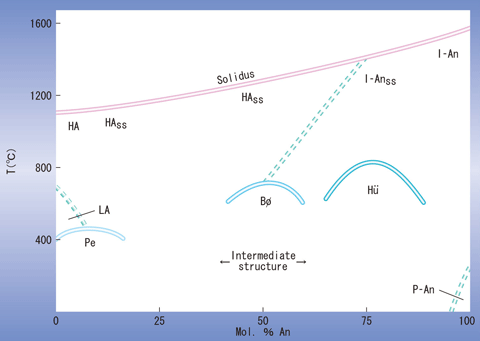We recently had an opportunity to identify pieces of feldspar from Tanzania showing blue to white iridescence. Our analysis revealed that these were eperisteritef, whose background and gemmological features are introduced here.
@@A chemical formula for feldspar is generally expressed as WZ4O8, and feldspar is a solid solution in which W and Z site can be widely replaced by Na, K, Ca or Ba, and Si or Al respectively. When considering gem varieties of feldspar, we need to understand at certain extent the relationship of three end members, which are K-feldspar (KAlSi3O8), albite (NaAlSi3O8) and anorthite (CaAl2Si2O8). Combination of factors such as ion diameter, electrical charge or electronegativity of each element of K (potassium), Na (sodium) and Ca (calcium), which consist three end members above, determine ease of forming a solid solution. Between K-feldspar and albite is called K-feldspar series that forms homogeneous solid solution in high temperature, however, it exsolves into two phase under low temperature. Between albite and anorthite is called plagioclase feldspar series that forms a continuous solid solution. As described later, however, immiscible region is also known in the plagioclase series (fig 1), which contributes to the optical effect seen in feldspar varieties.
 |
| Figure 1: |
Three unmixed phase areas seen in a plagioclase series (Deer et al. 1992)*Pe: peristerite unmixed phase |
|
@@The name moonstone originates in the German name Modestein that was used to describe a lustrous variety of feldspar by Werner in the late eighteenth century. According to GEMS by Webster that is a reliable reference book for gemmologists, moonstone is the important orthoclase feldspar gem, which shows blue to white schiller by interference effect and scattering of light due to a combination of orthoclase and albite - one end member of the plagioclase series - arranged in layers. A new edition Cyclopaedia of Earth Sciences by Heibonsya also define emoonstone is a stone in which orthoclase and albite are arranged alternately in thin films, and it shows beautiful flash light effect by cutting a crystal en cabochon with its base parallel to the plane of thin layers. Other literatures give almost the same definition on moonstone, and the material is recognised not as an independent mineral species but a gem variety of K-feldspar.
@@Returning to our subject, we recently had an opportunity to identify feldspars showing blue to white iridescence.(photo-1)
|
|
| Photo 1: |
peristeritef called a misnomer blue moonstone / samples courtesy of Mr. Masashi FURUYA of Japan Germany Gemmological Laboratory |
|
@@According to Mr. Masashi FURUYA of Japan Germany Gemmological Laboratory, who is knowledgeable about gemstone localities, these pieces are new product from Tanzania and are called blue moonstone in the industry. It looks like moonstone, but gemmological features were slightly different, with its RI range between 1.53 to 1.54 and SG 2.62 and 2.63 each of which are slightly higher than that of moonstone. It was inert under long wave ultraviolet light, but it shoed red fluorescence under short wave ultraviolet light. Centipede-like inclusion that is a characteristic feature to moonstone was not observed under a gemmological microscope, but needle-like inclusion and twin planes, which are seen in labradorite (see the June 2003 issue of this magazine) that has a similar appearance to moonstone, were observed.
|
|
|
| Photo 2: |
Needle-like inclusion seen in eperisteritef. |
|
| Photo 3: |
Twin planes often seen in eperisteritef. |
|
|
|
| Figure 1: |
Results of compositional analysis by X-ray fluorescence. |
|
X-ray fluorescence analysis revealed that this material is a plagioclase with under 10 mol% of anorthite (fig 2).A feldspar showing iridescence with this type of chemical composition is called eperisteritef, which was named for a Greek word peristera (means pigeon), as the light effect of the stone reminds of rainbow colours seen on a pigeon neck. The stone was further analysed its hyperfine structure by an electron microscope under Dr. Yasunori MIURA at the Faculty of Science of Yamaguchi University on our request.From the analysis, exsolution lamellae of almost pure albite and origoclase, which is called peristerite unmixed phase, was observed and that was turned to be a cause of the iridescence.
|
|
| Figure 1: |
Observation by an electron microscope (Miura 2005). Exsolution lamellae structure is clearly seen. |
|
|

















